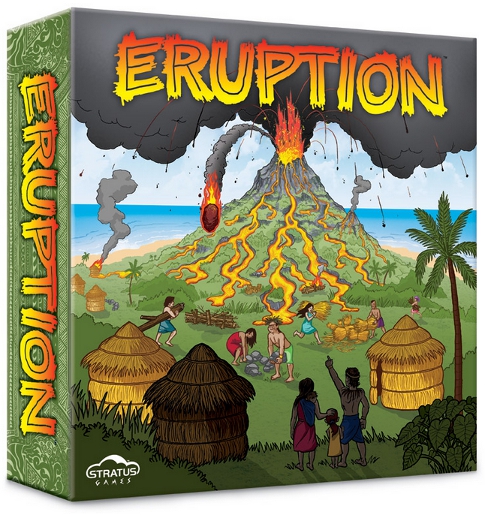
The Basics:
- For ages 7 and up (publisher suggests 10+)
- For 2 to 6 players
- About 45 – 60 minutes to complete
Geek Skills:
- Counting & Math
- Logical & Critical Decision Making
- Reading & Writing
- Pattern/Color Matching
- Strategy & Tactics
- Risk vs. Reward
Learning Curve:
- Child – Easy
- Adult – Easy
Theme & Narrative:
- An island paradise turns into a hot lava nightmare for its inhabitants!
Endorsements:
- Gamer Geek approved!
- Parent Geek approved!
- Child Geek approved!
Overview
In Eruption, players are trapped on an island paradise where the central volcano (that is, essentially, the island itself) is erupting. They must use what little materials they have to block the lava flows and redirect others into the sea, or preferably, rival villages. As the game progresses, it becomes more difficult with new eruptions on the island and even more lava spewing forth! The end result is a delightful little competitive game that plays fast, light, and is a whole lot of fun.
Eruption is comprised of 1 game board that depicts the island, 43 tiles (40 Lava and 3 Eruption tiles), 48 wooden walls (18 Straw, 15 Wood, and 15 Stone), 36 Action cards, 6 wooden scoring markers (one color for each player), and 2 six-sided dice (one white, one orange). All the components are high quality and detailed. I have found this to be typical of all Stratus Games‘ products I have had the pleasure to play and Eruption does not disappoint.
Game Set Up
To set up the game, place the game board in the middle of the playing area. Shuffle the Action cards and deal 3, face-down, to each player. Place the rest of the deck, face-down, to the side of the game board. Place the three Eruption tiles, face-down, next to the board, too. Shuffle the 40 Lava tiles and place them in the center of the board (on the volcano), face-down. Give each player 1 Straw, 1 Wood, and 1 Stone wall piece.
Each player will get 1 scoring marker, but the colors available to them is dependent on the number of players in the game. The positions of each player’s village is different depending on the number of total players. This ensures that the players are spread out as evenly as possible. Place the scoring markers on the “Start” position of the outside scoring track and have each player sit behind their village (or, as close as possible).
Last, each player rolls one of the six-sided die to determine who goes first. Highest number wins and turn order is clockwise.
You are now ready to play!
How to Play
A player’s turn is very straight forward at first. As the game continues and things heat up (see what I did there?), players will be given more actions. However, these additional actions are based on their initial turn sequence and are easy to incorporate into the game without having to stop the game to reteach new rules.
On a player’s turn, they will always to the do the following in sequential order:
1. Assess Damage
Player’s always review the current damage being done to their village and adjust their position on the “Burn Meter” that surround the island. The Burn Meter serves to indicate the current level of danger on the island, introduces additional actions, and keeps track of points.
Lava that is touching their village without being blocked by a wall made out of Straw, Wood, or Stone adds 20 to the player’s current Burn Meter value. Walls are temporary measures and will eventually give out given time. While they stand, the village is safe. If they should fail, 10 points are added to the player’s current Burn Meter value for every failed Wall on this turn.
2. Draw and Place Lava Tile
Player’s take 1 Lava tile from the center of the board and place it on the island, connecting lava flows. Lava tiles must always be placed if possible. If it is impossible to place the tile, a new one is drawn and placed. If a Lava tile is ever placed on a tile with a resource (Straw, Wood, or Stone), the player is awarded one Wall of that type to be used during their turn if they want.
Placing Lava tiles is an excellent exercise in pattern matching and should be very straight forward.
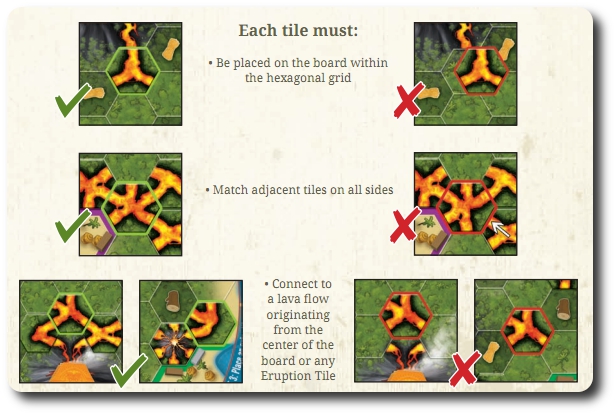
Easy tile placement rules makes the game fun for your little geeks and easy to play for all
Additionally, Lava tiles may flow into Villages and off the board. If you place a Lava tile and it hits a village, you are awarded 1 Action card for every village border the lava hits.
Lava may not touch the center of the board where lava does not currently exists.
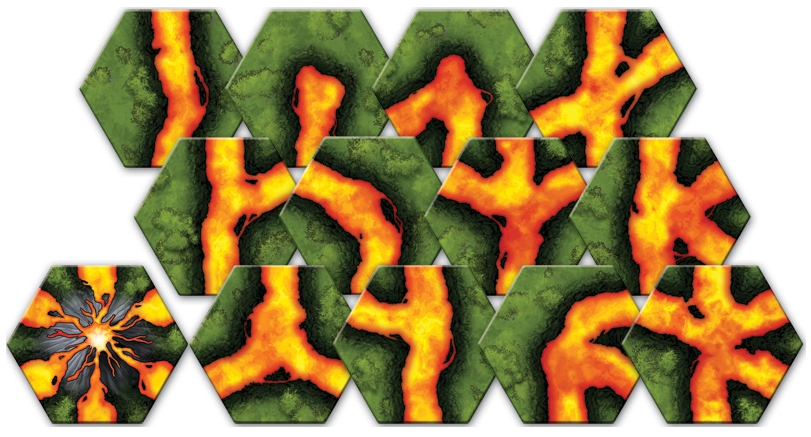
Example of the Lava tiles and the Eruption tile that causes a great deal of trouble
3. Play Action Cards (or Don’t)
The Action cards provide the players actions they otherwise would not be able to do, but at the cost of using the card. Action cards can also be discarded for the Wall resource pictured on the card or 2 can be discarded to draw and place another Lava tile.
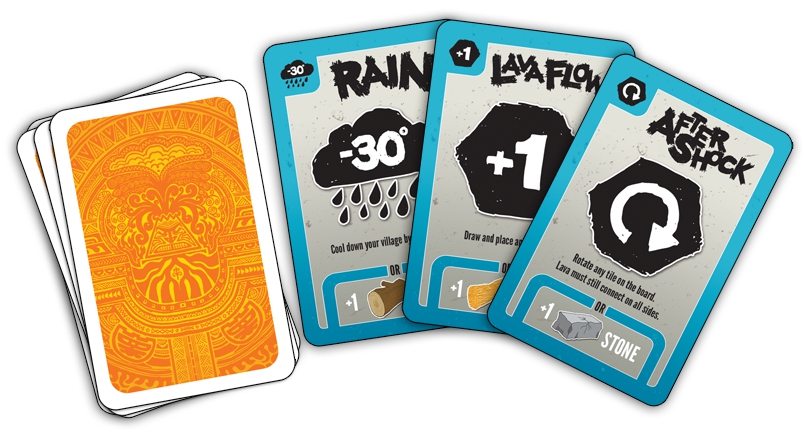
Action cards provide specific actions or specific Wall - either way, very useful!
Players are only given 3 Action cards at the beginning of the game and will be not be able to obtain new ones until lava is burning their village or they burn another player’s village with lava. A player is also limited to only 3 Action cards in their hand by the end of their turn.
4. Build Wall (or Don’t)
If the player has any unused Walls, they can now place one of them on the board, unless their current placing on the Burn Meter states they can place more than one.
Walls are placed on one of the sides of the polygon board spaces occupied by a Lava tile. Whatever side they are on is the side that is blocking the lava from continuing its flow. Multiple Walls can be built around Lava tiles for extra protection. Lava can flow around Walls, however, if not blocked.
The only exception to the Wall placement rule is placing a Wall on the village colored border. A Wall can be placed on the village colored border at any time and does not require a Lava tile to be present.

Walls are very useful, but eventually fail
Wall Strength
All walls are temporary – they will fail eventually. Depending on the material the wall is made of, they might be breached almost immediately or much later in the game. Walls serve to protect villages and to stop the flow of lava flows. Whenever a player wants to place a Lava tile next to anther Lava tile that currently has a Wall built on it, that player first rolls to see if the wall holds or fails. Likewise, during the player’s Assess Damage step, a dice roll is done to see if the wall can withstand the heat or fail.
To see if a wall fails or not, a player rolls the 2 six-sided die. The orange die represents the lava and the white die represents the wall. Whichever die value is higher wins. If the lava wins the wall is removed. If the wall wins the lava is unable to breach the fortification and tiles cannot be placed or the village survives for another round.
Different wall materials have different strengths. The following is added to the die roll for the wall depending on the material it is made out of:
- Straw: +0
- Wood: +1
- Stone: +2
The Burn Meter
The Burn Meter keeps track of the overall damage to the island and chaos. Once a player’s scoring piece travels into different danger zones, they are given additional actions. If their scoring piece ever moves backwards, decreasing in value and moving out of the danger zone, they lose any additional actions the danger zone provided. If their scoring piece ever moves forward, increasing in value, they keep whatever additional actions the previous dangers zones provided including the new one.
- Danger Zone 1: player can build 1 extra wall this turn
- Danger Zone 2: player can draw 1 Action card and build 1 extra wall this turn
- Danger Zone 3: player can place one extra Lava tile, draw 1 Action card, and build 1 extra wall this turn
The Burn Meter also indicates when one of the 3 Eruption tiles come into play. The first player to land on or pass an Eruption space on the Burn Meter takes the corresponding Eruption tile and places it on the board after they assess damage.
Each Eruption tile is like a new volcano and becomes a new source for lava to flow from. As such, Eruption tiles can be placed just about anywhere on the island, shifting the game in a player’s favor and causing much grief for others. Eruption tiles do not need to connect to an existing Lava tile, but if it is, all lava flows must connect correctly. Additionally, if an Eruption tile is placed next to a Lava tile, any Wall on the sides that connects the two is immediately destroyed.
Once the Eruption tile is placed, all player’s go up on the Burn Meter by 30! Yikes!
And in case you are wondering, yes, you can place an Eruption tile right outside another player’s village!
Winning the Game
The game ends when a village is burned completely (the player’s scoring piece reaches the end of the Burn Meter) or the stack of Lava tiles is exhausted or none remaining can be played. Every player gets one more turn and then the final score is determined.
The winner of the game is the player who managed their risk the best and kept their village damage down. This is determined by the lowest score on the Burn Meter.
Game Variants
Eruption is a great game with just the standard rules, but if you are looking for something a little different, there are several game variants available to you and your game group.
- Clans: allows for team play for 4 or 6 player games
- Annihilation: the game continues until only one player is left
- Lava Forecast: three stacks of Lava tiles, face-up, are used instead of the blind draw
The complete rules and a video can be found on the game’s official web site.
Prediction
There is nothing to predict on this one. I already know my little geeks love the game. You see, we were lucky enough to be able to try Eruption as an early Print-and-Play copy. Read our early peek at Eruption to see just how far this game has come in a very short time!
But since I love quotes, here is what my two oldest little geeks said when they saw Eruption in all its glory
“WOW! This looks a lot better than our other copy of the game!” ~ Liam (age 7)
“Dad, can I have the other game for my own?” ~ Nyhus (age 4)
Wow…shortest prediction ever. Call Guinness, this has got to be a record breaker.
Final Word
My little geeks and I had twice the fun with the final version of Eruption as we did with the Print-and-Play version (man, I hate my printer). There is just something about a fully developed and well published game that makes the experience all the more enjoyable. My 4-year-old played with me and did a great job with the tile placement but failed to recognize the subtle strategy and tactics in the game. My 7-year-old had no problem with the game and did a very good job with damage control as well as causing damage.
After having played Gold Mine a great deal with my little geeks, Eruption was a very welcomed change of pace. Eruption is a much more of a Gamer’s game without being any more difficult. My little geeks immediately recognized this and spent more time thinking about their tile placement then they did with Gold Mine. There’s a very good reason for this.
Eruption is a game about survival and outlasting your opponent. The game will push all the players to the end, eventually. It is simply a question of who can dodge and avoid the lava damage the longest. In short, everyone is going to be burned. It provides that feeling of “we are all in this together” that cooperative games provide but you know full well you’re going to push your fellow players out in front of the lava the first chance you get. In that respect, Eruption reminds me a good deal of another favorite of mine, Cutthroat Caverns, where players must work together to survive, but only to a point.
Another really interesting aspect of the game is the management of not only your Burn Meter value but also your opponents and the dual role of being offensive as well as defensive. If you put all your time and energy into trying to burn your opponent’s villages, you will leave yourself open. However, if you spend all your energy in protecting yourself, you’ll be out flanked in no time. This provided my little geeks a wonderful experience of true risk vs. reward and we stopped our games often to discuss outcomes of different strategies.
In the end, however, the best course of action for my little geeks was to always burn their dad’s village.
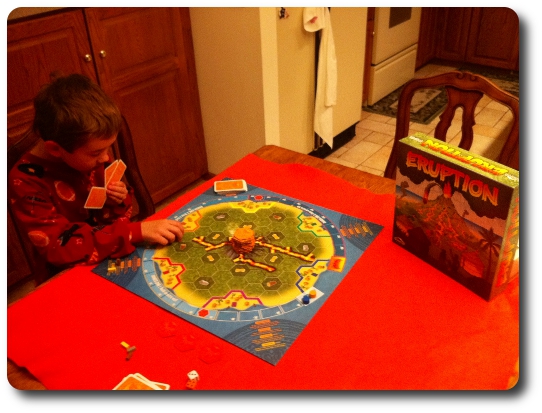
My little geek was immediately engaged in the game and became terribly excited when he started to burn his father's village
Gamer Geeks, this is a great, light strategy game with enough player stabbing and area control to keep you interested. The more devious players will quickly see the benefit of managing their Burn Meter value to gain additional actions and force the end game on players who are having a difficult time managing the lava flows.
Parent Geeks, Eruption is a wonderful game for the entire family. If you have played and enjoyed Status Game’s other title, Gold Mine, you will find Eruption to be an excellent next game to jump to. It uses many of the same core game mechanics and builds on them. This makes for a nice bridge to a more difficult game without your family feeling like they are learning a new game from scratch.
Child Geeks, you are going to really enjoy Eruption! You get to take control of the lava and turn it towards your opponents or stop a lava flow from reaching your village by stopping or redirecting the flow yourself. Fun and fast, you’ll be looking forward to this game on the family table!
Eruption is a great family game and appeals to all age groups and all skills groups that I have played it with. I believe I’ve been quoted on the Status Games web site stating that Eruption is “As good as it gets…Stratus Games has got a hit on their hands.” I stand by this statement. This game is fun, fast, easy to teach, easy to enjoy, and is very well produced and designed. From the little bits to the complete package, Eruption is a solid game well worth your time.
This game was given to Father Geek as a review copy. Father Geek was not paid, bribed, wined, dined, or threatened in vain hopes of influencing this review. Such is the statuesque and legendary integrity of Father Geek.




Pingback: Father Geek » Early Peek at DiceAFARI